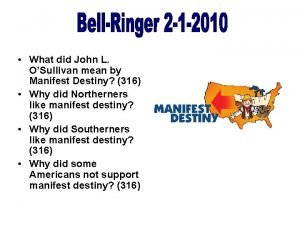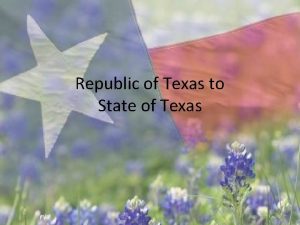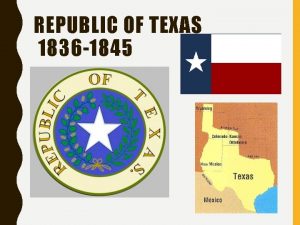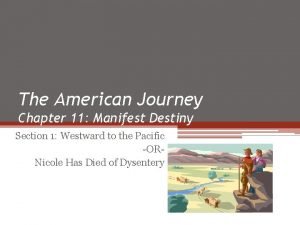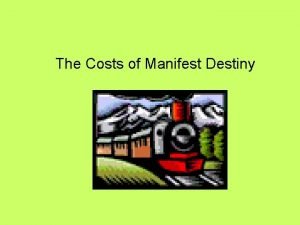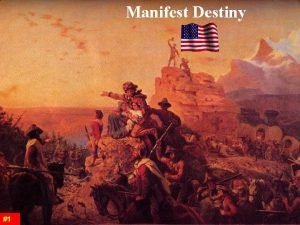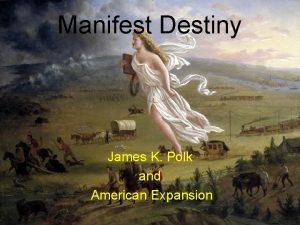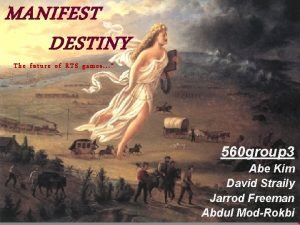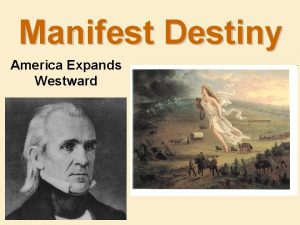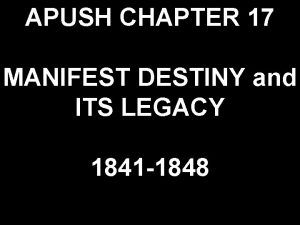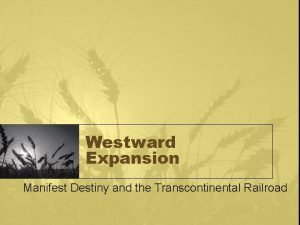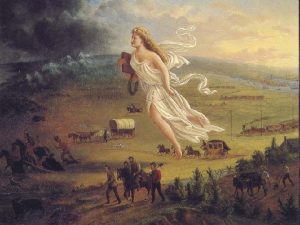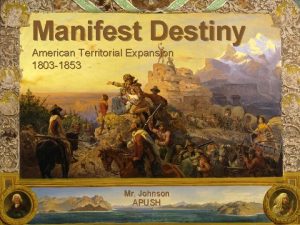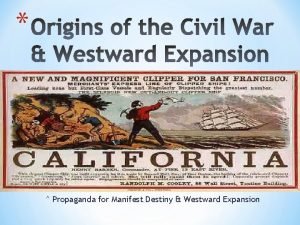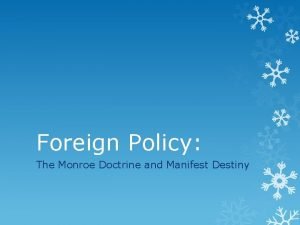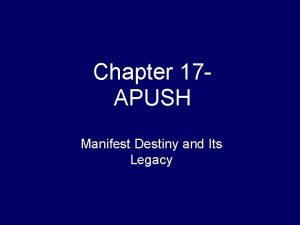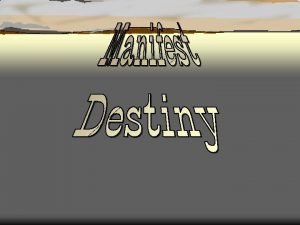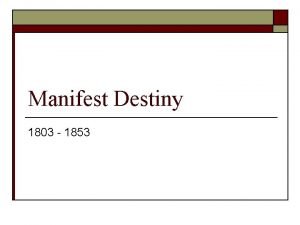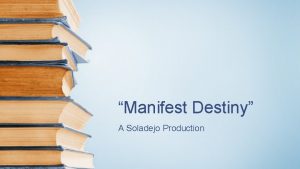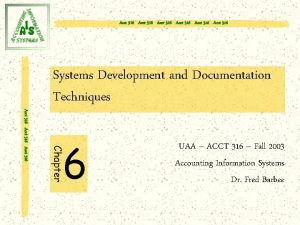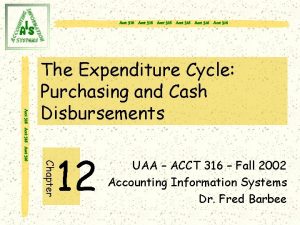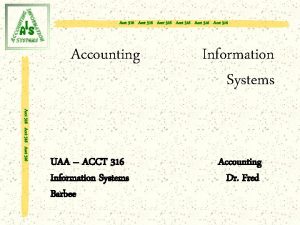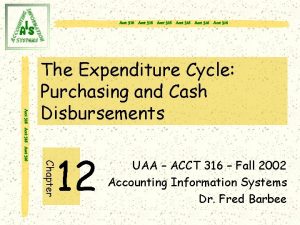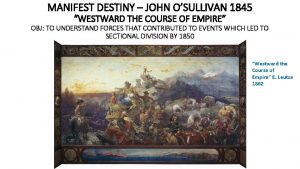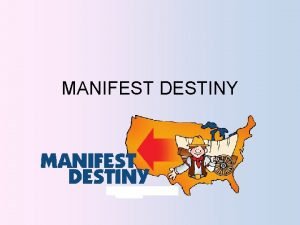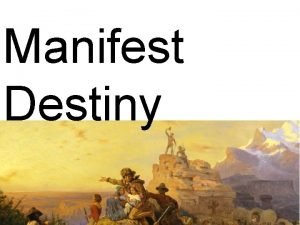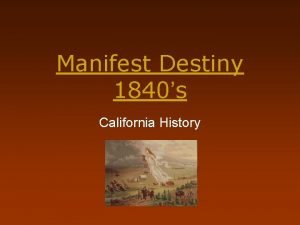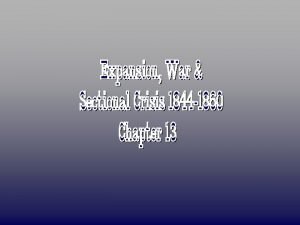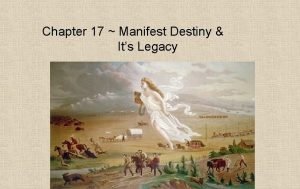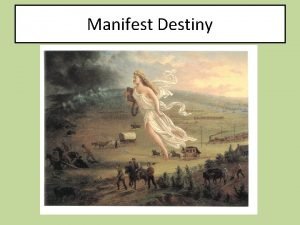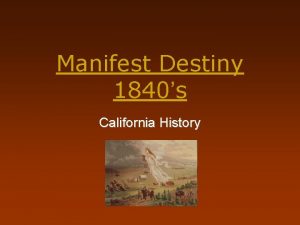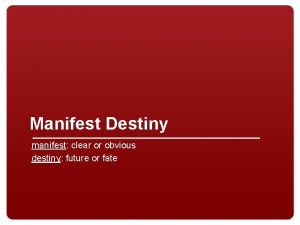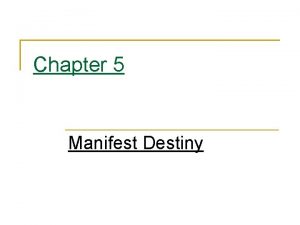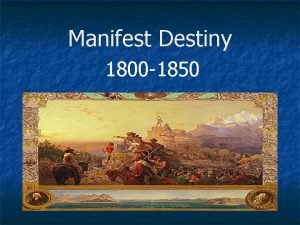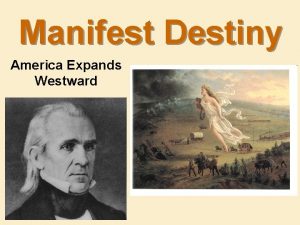MANIFEST DESTINY 316 Manifest Destiny 1845 John L






















- Slides: 22


• MANIFEST DESTINY: (316) – Manifest Destiny: 1845, John L. O’Sullivan, a magazine editor, coined the phrase MANIFEST DESTINY – Manifest Destiny – God intended the United States to expand westward – O’Sullivan argued that the United States should extend its western boundary all the way to the Pacific Ocean

• MANIFEST DESTINY: (316) – The idea of manifest destiny appealed to many Americans • Northerners troubled by economic problems and urban crowding hoped that western expansion would lessen population pressures and create new markets for industrial products • Southerners wanted western lands for increased cotton production

• MANIFEST DESTINY: (316) – Not all Americans supported manifest destiny. – Some objected to expansion because many western lands were already claimed by other nations – Others feared that expansion would make the United States too large to govern effectively

• MEXICAN TEXAS: (317 -318) – The growing presence of U. S. settlers in foreign territory was particularly visible in Texas. This immigration increased significantly after Mexico won it’s independence from Spain in 1821 – Mexican officials wanted to boost the non-American Indian population of Texas. To do this, they offered extremely cheap land freedom from taxation to U. S. citizens who agreed to settle in the territory

• MEXICAN TEXAS: (317 -318) – Mexican officials feared that the United States, which had twice tried to purchase Texas, would one day take the territory by force – The few thousand Tejanos – native Mexicans who lived in Texas – stood little chance of blocking an invasion – If Mexico could recruit enough U. S. settlers and turn them into loyal Mexican citizens, the country might be able to build a defensive force large enough to prevent a U. S. invasion

• MEXICAN TEXAS: (317 -318) – To reduce the cultural influence of U. S. settlers in Mexico, the Mexican government also tried to recruit settlers from other foreign countries. – It also did not offer land to every person who wanted it. Rather, it gave generous land grants to empresarios, people who agreed to recruit and take responsibility for new settlers. – These empresarios attracted thousands of people to Texas during the 1820 s – Stephen F. Austin established a colony on the Gulf Coast of Texas in 1821

• TEXAS REVOLUTION: (318 -320) – By 1830 non-Mexicans in Texas outnumbered Tejanos, native Mexicans who lived in Texas, by out 2 to 1 – Most of the new arrivals made little effort to learn Spanish or adapt to Mexican culture – Although required to become Catholic, most privately continued to practice their own faith

• TEXAS REVOLUTION: (318320) – Fearing a rebellion in Texas as well as a U. S. invasion, Mexico closed the Texas border to additional immigration from the United States in 1830 – The Mexican government also prohibited the importation of slaves to Texas – ALL THESE MEASURES DID LITTLE TO SLOW IMMIGRATION. • By 1835 about 30, 000 U. S. settlers, including some 3, 000 slaves, lived in Texas. Many had entered illegally

• TEXAS REVOLUTION: (318320) – Trouble Brews: (318 -319) • U. S. immigrants to Texas deeply resented the 1830 measures. • Slaveholders feared that Mexican authorities would soon restrict the practice of slavery – Although Mexican legislature had banned slavery, Texans had negotiated a special law that classified their slaves as indentured servants – Many Texans feared that the cotton industry would collapse if the government overturned the law

• TEXAS REVOLUTION: (318320) – Trouble Brews: (318 -319) • Tensions grew worse in 1833. After being elected president, General Antonio Lopez de Santa Anna established dictatorial control over the Mexican government • This angered residents of many Mexican territories, including Texans • Mexican authorities jailed Stephen F. Austin, who had gone to Mexico City hoping to resolve Texans’ conflict with Mexican authorities peacefully.

• TEXAS REVOLUTION: (318320) – Trouble Brews: (318 -319) • By the time Stephen F. Austin was released from jail in 1834, he had given up hope of a peaceful settlement. He said, “War is our only recourse [option], ” he advised his fellow Texans. • Outraged US settlers and Tejanos rose up in revolt the following year. • Isolated clashes with the Mexican military quickly grew into a fullscale rebellion known as the Texas Revolution

• TEXAS REVOLUTION: (318 -320) – The Alamo and Goliad: (319 -320) • Alamo: a mission-fort built by the Spanish, at least 189 Texas rebels led by William Travis and Jim Bowie fought off repeated attacks by Santa Anna’s, leader of Mexican troops, army • On March 6, 1835, Mexican troops finally overran the fort, killing all of the Texas rebel fighters.

• TEXAS REVOLUTION: (318 -320) – The Alamo and Goliad: (319 -320) • Alamo: – Susanna Dickinson, a released civilian, had her husband had been killed in the fighting. – Dickinson’s account of the final days of the Alamo became widely known throughout Texas. She claimed that at one point William Travis had drawn a land in the sand saying that if wanted they could cross over and not fight. According to legend, all stayed – The story added to the status of the Alamo defenders and spurred other Texans to support the cause of independence

• TEXAS REVOLUTION: (318 -320) – The Alamo and Goliad: (319320) • Goliad: After Mexican troops defeated a rebel army near Goliad, some 400 surviving Texans surrendered. • General Santa Anna, of the Mexican Army, ordered that the prisoners be executed: • Francita Alavez, a wife of a Mexican officer, saved some Texans by hiding them from Mexican soldiers. She became known as the “Angel of Goliad. ”

• BOTH THE ALAMO AND GOLIAD FURTHER FUELED ANTI-MEXICAN FEELINGS

• TEXAS REVOLUTION: (318 -320) – Victory at San Jacinto: (320) • Even though the Texans declared their independence from Mexico on March 2, 1835, the Texan army was badly shaken by the defeats at the Alamo and Goliad • Led my Sam Houston, commander of the Texas army, a force of approximately 900 rebels surprised Santa Anna and his troops. • The Mexican soldiers were taking an after-noon nap near the San Jacinto River. They were shouting “Remember the Alamo!” and “Remember Goliad!” • The Texans tore through the Mexican lines, killing some 630 Mexican troops and taking Santa Anna prisoner in the Battle of San Jacinto

• TEXAS REVOLUTION: (318 -320) – Victory at San Jacinto: (320) • With his army weakened and supplies low, Santa Anna signed a treaty granting Texas its independence • A short time later in 1836, Texans elected San Houston as the first president of the independent Republic of Texas • The Mexican government refused to recognize the Republic of Texas arguing that Santa Anna was forced to sign the San Jacinto agreement illegally.

• LIFE IN THE REPUBLIC OF TEXAS: (320 -322) – Texas petitioned the U. S. Congress for annexation in 1837. However, northern opposition to admitting another slave state as well as a cautious foreign policy toward Mexico prevented Texas from being accepted into the Union immediately – From 1835 -1845 Texas existed as an independent republic. THAT IS WHY TEXAS IS KNOWN AS THE LONE STAR STATE

• LIFE IN THE REPUBLIC OF TEXAS: (320322) – French and German Immigration: (320321) • One of the Republic’s first tasks was to increase its population – Henri Castro, a French banker of Portuguese descent, was granted an empresario, land grant, in central Texas by the Texas government. Two years later Castro brought 35 French colonists – many of them from the German-speaking region of Alsace in France – Over the next few years more than 7, 000 German immigrants cane to live in what they called the “Paradise of North America. ” – MANY GERMANS SETTLED IN TEXAS

• LIFE IN THE REPUBLIC OF TEXAS: (320 -322) – Discrimination against Tejanos: (321) • Tejanos: Native Mexicans who lived in Texas • The Tejanos did not do as well as the German settlers in the Lone Star Republic. • After Texas achieved the Tejanos became victims of violence and discrimination. • Many of their lands and property were seized by white Texans; some were even kicked-out of the country • Juan Seguin, a leading Tejano figure in the Texas Revolution, helped the Texans against the Mexicans in the Battle for the Alamo. • Even though he fought with the Texans he faced discrimination because he was a Tejanos.

• LIFE IN THE REPUBLIC OF TEXAS: (320 -322) – The Economy and Defense (322)
 John o sullivan manifest destiny
John o sullivan manifest destiny John l osullivan
John l osullivan Deltapine 1845
Deltapine 1845 Texas in 1845
Texas in 1845 Republic of texas map 1845
Republic of texas map 1845 Manifest destiny 1840s
Manifest destiny 1840s Manifest
Manifest Costs of manifest destiny
Costs of manifest destiny American progress book
American progress book Manifest destiny effect
Manifest destiny effect Manifest destiny poems
Manifest destiny poems Rio grande river
Rio grande river Manifest destiny book
Manifest destiny book Define manifest destiny in your own words.
Define manifest destiny in your own words. Apush chapter 17
Apush chapter 17 Manifest destiny railroads
Manifest destiny railroads Manifest destiny book
Manifest destiny book Manifest destiny
Manifest destiny What did manifest destiny predict?
What did manifest destiny predict? Manifest destiny propaganda
Manifest destiny propaganda Monroe doctrine and manifest destiny
Monroe doctrine and manifest destiny Jim bowie
Jim bowie Manifest destiny newspaper
Manifest destiny newspaper

